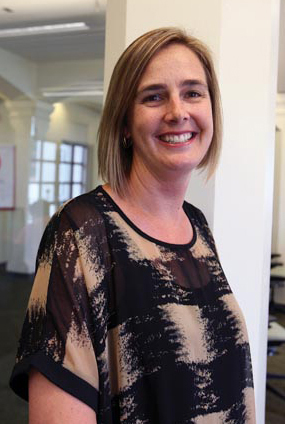Integrating Teaching and Technology
By Marya Jones Barlow

Students in Associate Professor of Education Jill Leafstedt’s Individuals with Disabilities in Society class never enter a lecture hall, buy a textbook or take a written exam. Instead, they log in to her class website for learning modules that prompt them to watch videos, read texts, engage in online class discussions and interactive assignments, go on Internet scavenger hunts for information, and meet course learning objectives by collaborating, creating and researching.
“Technology is bringing down the walls of the classroom and changing our entire purpose as educators,” Leafstedt said. “Students today are networked, mobile learners who need multiple inputs to stay engaged. Knowledge is no longer housed within a space or a person. We need to shift how we think about our jobs from being deliverers of information to being a facilitators of knowledge.”
As Director of Teaching and Learning Innovation (TLI) at CI, Leafstedt helps other faculty bring a more technology-based approach to their own courses. She stays up-to-date on the latest innovations in online learning, sharing success stories and highlighting helpful software and best practices from CI colleagues and other educators who are leading the way.
In her role as Director of TLI, Leafstedt also facilitates CI’s Blended Learning Preparation Program (BLPP), in which she meets weekly with faculty members who want to redesign their courses to incorporate technology more effectively and replace a portion of face-to-face class time with online coursework. So far, 30 faculty members have taken advantage of the program over the course of three semesters. Participating faculty have embraced changes such as “flipping the class”—allowing students to watch lectures online so class time can focus on discussion—or having students do presentations online so class time can focus on constructive feedback and discussion. Others have implemented changes that enable greater engagement in learning, such as interactive video discussions and student-created digital content.

“The BLPP program has transformed my view of online education,” said Kathryn Leonard, Associate Professor of Mathematics. “Jill has created experiences that demonstrate how much more online learning can be than just an information delivery system—it allows for deeper and more interesting student assignments, for creating a strong sense of community quickly and effectively, and for individually targeting students in the areas they need the most support.”
Leafstedt’s appreciation for teaching and technology started at an early age. Her mother and grandmother—both elementary school teachers—encouraged her to become a teacher. Her father, a technology buff, bought one of the first Apple computers in the neighborhood and ensured his daughter went off to college with a computer. Leafstedt went on to earn her undergraduate degree in psychology and her Ph.D. in education with an emphasis in special education, disability and risk studies and an interdisciplinary emphasis in cognitive science at UCSB. All the while, she maintained an interest in technology, working on a federal grant project to develop some of the first online modules for teachers as a grad student.
“The main focus of my role with technology has been to change the conversation from ‘Online is scary and not engaging’ to ‘Wow, that’s cool, I bet my students would love to try that,’” Leafstedt said. “Technology aside, this has been a wonderful opportunity to bring faculty together to talk about student learning.”
“I am now able to integrate technology better into my teaching in efficient, practical, and meaningful ways,” said Antonio Jiménez Jiménez, Associate Professor of Spanish. “Even though I have always felt comfortable with new technologies, Jill’s program has allowed me to learn new ones and, more importantly, how to best apply them in a way that makes sense with what I want to accomplish in the course.”
While this is high praise, Leafstedt’s favorite compliment came from a student who recently took one of her blended learning courses.
“He told me, ‘In other classes, the discussion ends when the class time is up. I love that in this class our discussion—and my thinking—goes on and on,” she said. “That’s what it’s all about."
